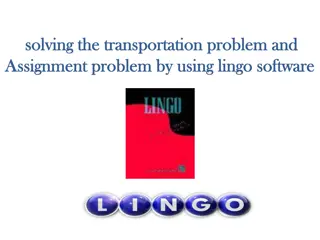Understanding Learning Lingo: Curriculum and Models in Education
The content delves into the complexities of learning lingo, exploring terms such as learning theory, curriculum theory, instructional models, strategies, and methods in education. It covers various instructional models like Understanding by Design and Universal Design for Learning, providing insights into creating effective lesson plans and addressing different learning styles.
Download Presentation

Please find below an Image/Link to download the presentation.
The content on the website is provided AS IS for your information and personal use only. It may not be sold, licensed, or shared on other websites without obtaining consent from the author. Download presentation by click this link. If you encounter any issues during the download, it is possible that the publisher has removed the file from their server.
E N D
Presentation Transcript
Learning Lingo A confusing, and confounding endeavor for educators Debra Spielmaker & Max Longhurst Utah State University
Learning Lingo Learning Theory Curriculum Theory Instructional Models Instructional Strategy Method Technique Think, pair, share: What is a quick definition and example for one of the Learning Lingo terms?
Learning Lingo Learning Theory: How people learn, links to instructional models (see handout). Curriculum Theory: Framework for what should to be taught. Instructional Models: Philosophical orientation to instruction. Instructional Strategy: Within each model several strategies can be used. Strategies determine the approach a teacher may take to achieve learning objectives. Strategies can be classed as direct, indirect, interactive, experiential, or independent. Method or Approach: Methods create learning environments to specify the nature of the activity in which the teacher and learner will be involved during the lesson (technique is used synonymously). The method is modified for differences among learners.
Instructional Models Understanding by Design: UbD, Backward design, Essential Questions, Big Ideas (1998) Universal Design for Learning (UDL, 2000) Differentiated Instruction Multiple Intelligence/Learning Style? 5Es BSCS (Biology Sciences Curriculum Study, 1987) Project-Based Learning
UbD Jay McTighe: What is Understanding by Design?
Bryan Dean, on UDL Bryan Dean, CAST PL Oakland Schools, MI https://www.rubicon.com/5-insights-udl/
UDL-Lesson Planning Flow Chart Choice about how students show what they know Assessments as Learning / Metacognition I think about how I learn Lesson Information (subject/grade level) Methods for Students to: notice the ways they learn best based on choices and variety provided and/or plan to improve their learning by choosing ways to learn that work best for them Variety or choices in how information is presented or materials provided Instructional Goals Possible Barriers: who may be left out focus on learner characteristics Potential Lesson Activities
Instructional Strategies and Methods Direct Instruction structured overview, mastery lecture, demonstration, drill & practice, compare & contrast, didactic questions, guides for reading, viewing & listening Interactive Instruction debates, role playing, panels, brainstorming, peer practices, discussion, interviewing, cooperative learning groups, PBL Indirect Instruction problem solving, case studies, reflective discussion, concept mapping, reading for meaning, inquiry Experiential Learning Independent Study field trips, conducting experiments, games, field work, model building, model manipulation role playing, simulations, PBL, storylines (phenomena), 5Es essays, computer modules (ADDIE), reports, learning contracts, research projects, learning centers http://teachinglearningresources.pbworks.com/w/page/19919560/Instructional%20Approaches
What is the 5E Instructional Model? An instructional model based on the constructivist learning theory (i.e., help learners develop understanding on their own) Draws on students existing knowledge, beliefs and skills Student synthesize new understandings from prior learning and new information Teacher sets up the scenario for a problem and monitors student expiration, guides student inquiry, and promotes critical thinking Engage Evaluate Explore Elaborate Explain
Why use the 5E Instructional Model? The model is supported by science teacher educators and NSTA Research-Based, flexible, works with nearly all curricular subjects and other instructional methods and assessments Creating the 5Es Teacher & Student Behavior
National Agricultural Literacy Curriculum Matrix Template & Rubric are based on 5E model Instructional Tools Wiki Tutorials on how to submit a lesson to the Matrix Example: The Science of a GMO Let s Play - Engagement: https://Kahoot.it; Game Pin is
Learning Lingo I speak your language! Debra Spielmaker & Max Longhurst Utah State University























